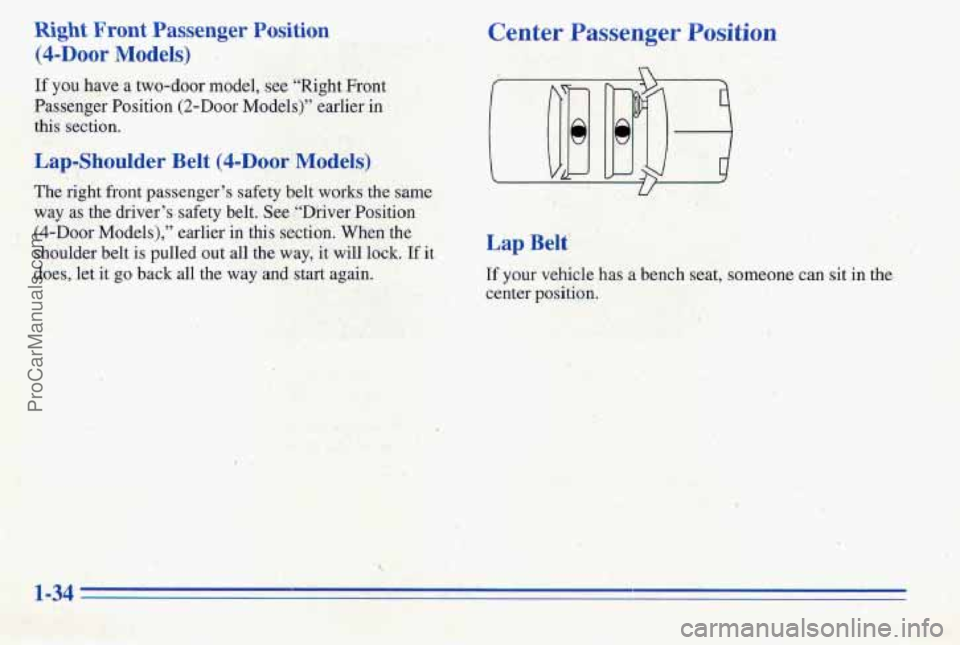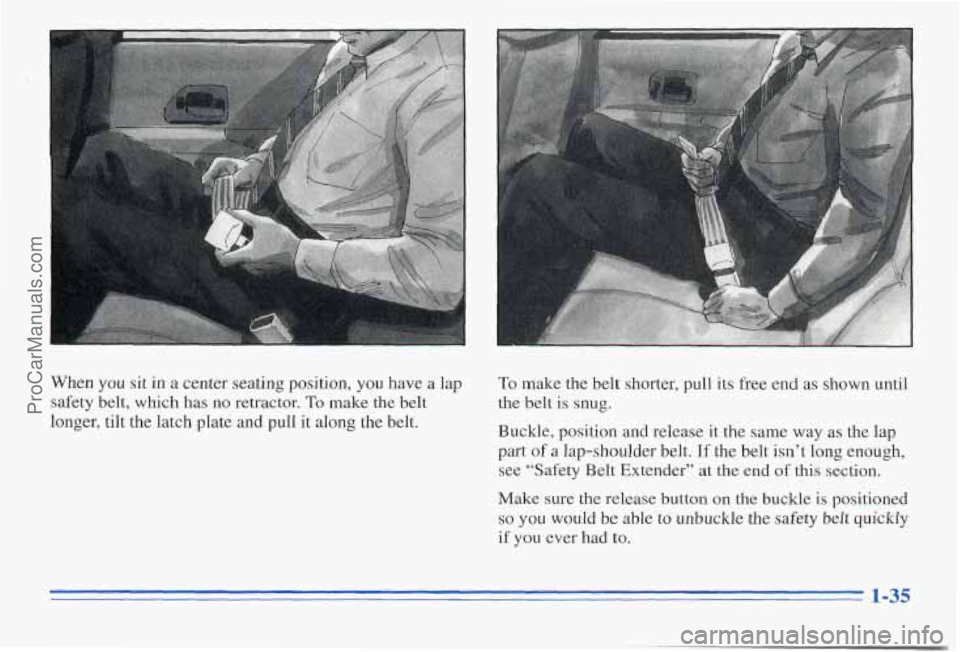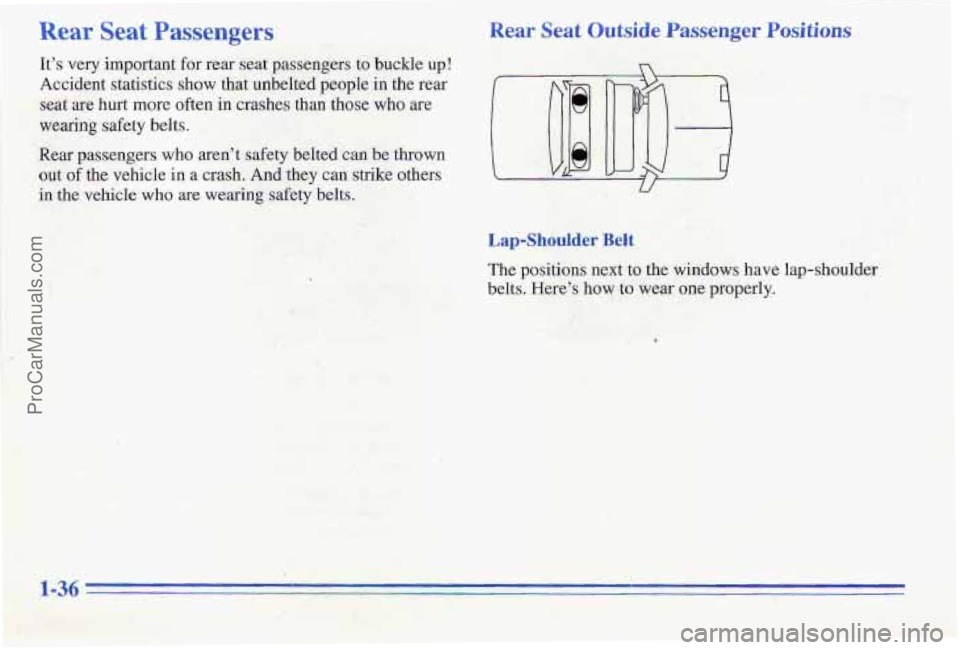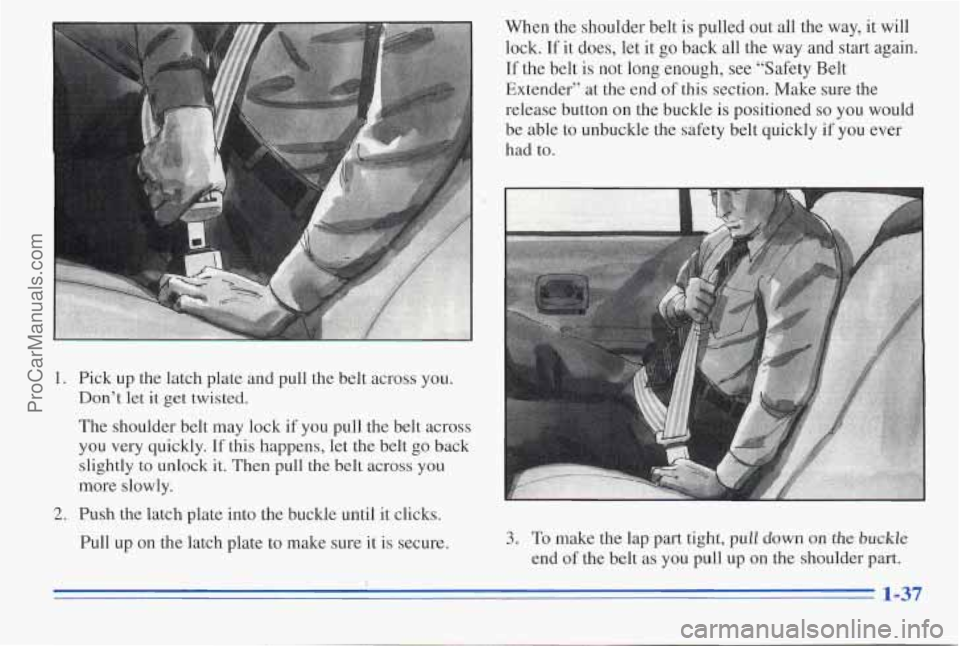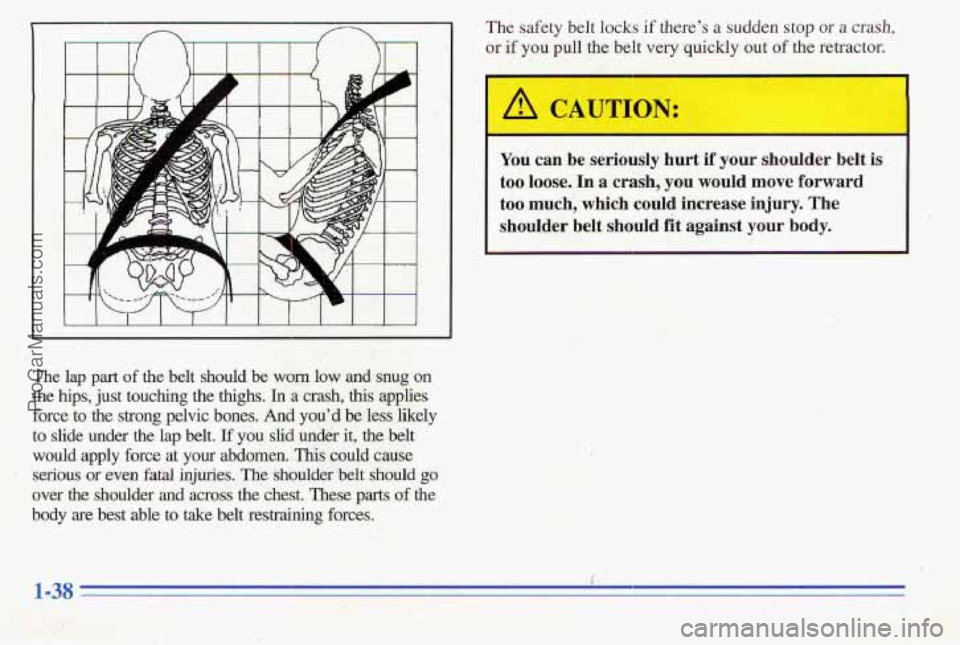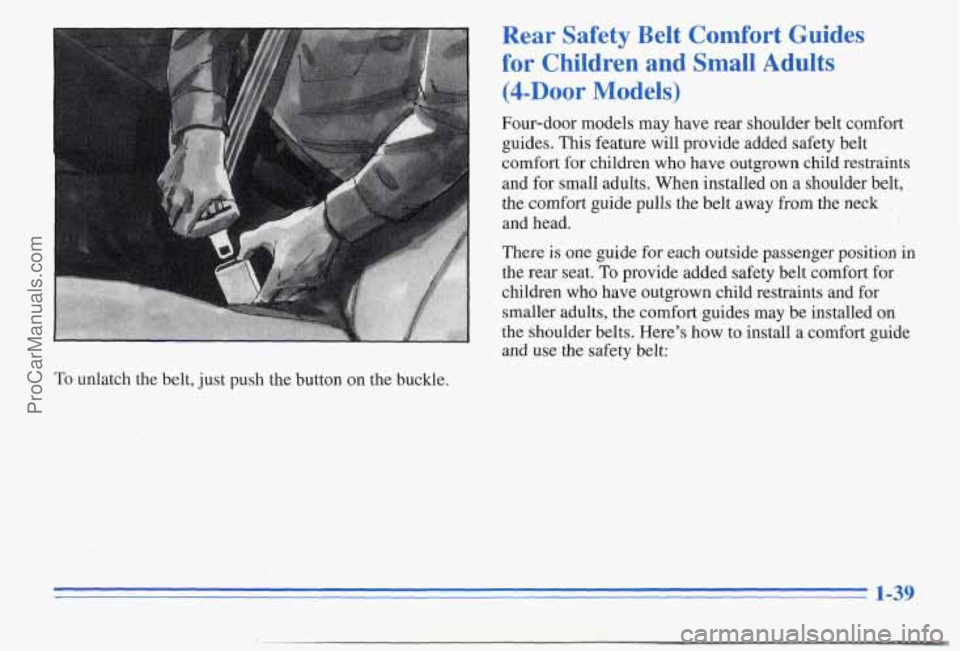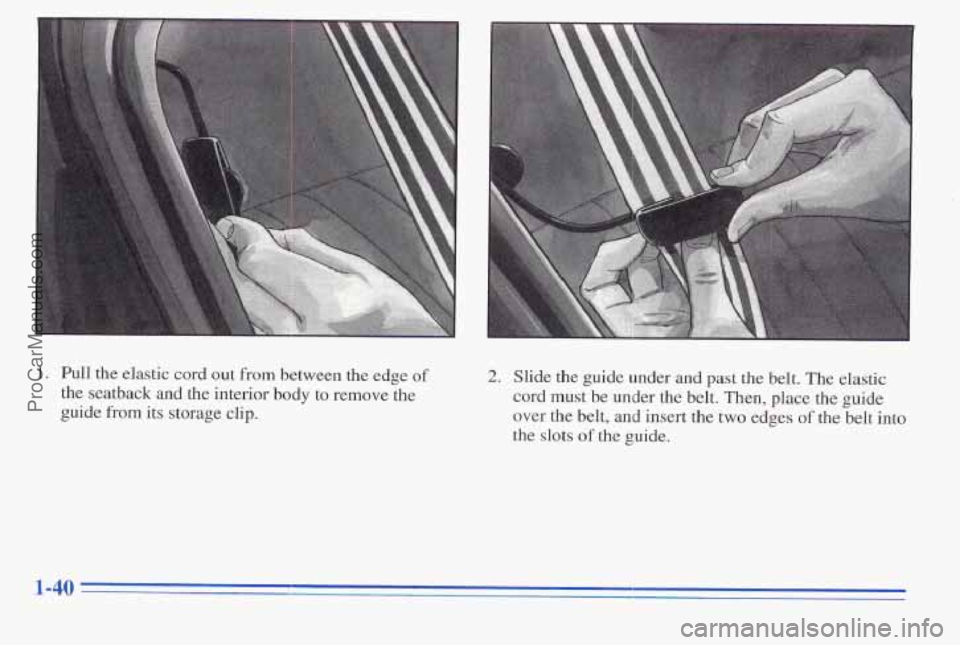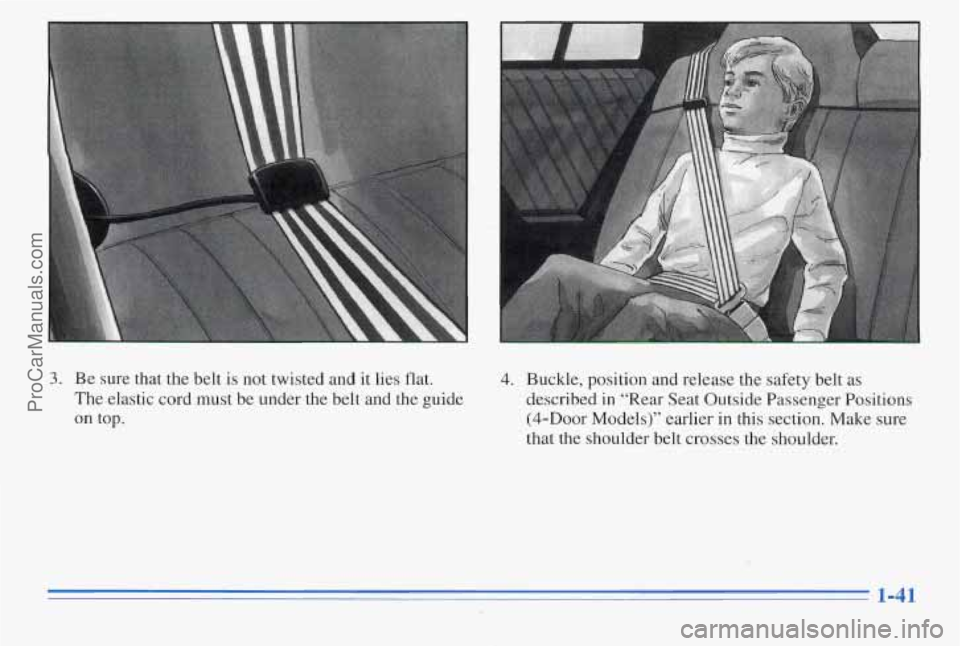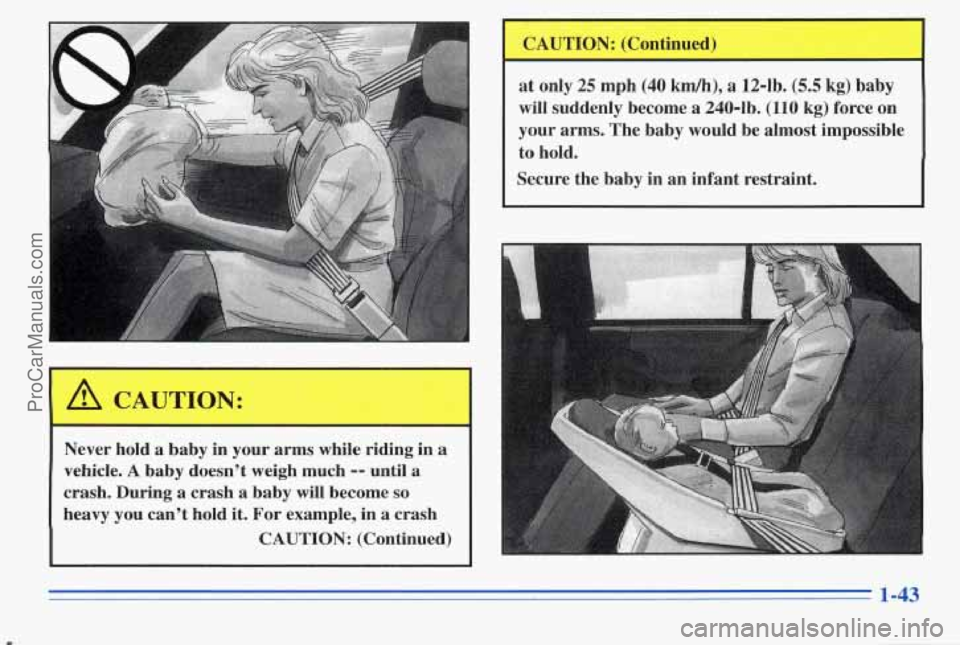PONTIAC PONTIAC 1996 Service Manual
PONTIAC 1996
PONTIAC
PONTIAC
https://www.carmanualsonline.info/img/50/58390/w960_58390-0.png
PONTIAC PONTIAC 1996 Service Manual
Trending: maintenance schedule, wiper fluid, change wheel, engine oil, headrest, fuel additives, change language
Page 41 of 370
Right Front Passenger Position
(4-Door Models)
If you have a two-door model, see “Right .Front
Passenger Position
(2-Door Models)” e,arlier in ,
this section.
Lap-Shoulder Belt @-Door- Models)
The right frzant passenger’s safety belt works the same
way
as the driver’s. safety belt. See ‘‘D~vver Position
(4-D,oor Models),” earlier
in this secti’on. When the
shoulder belt is pulled out all the way, it will lock. If it
does, let it go back all the way and start again.
I
Center Passenger Position
Lap Belt:
If your vehicle has a bench seat, someone can sit in the
center position.
‘, ,I -.
ProCarManuals.com
Page 42 of 370
When you sit in a center seating position, you have a lap
safety belt, which has no retractor.
To make the belt
longer, tilt the latch plate and pull it along the belt.
To make the belt shorter, pull its free end as shown until
the belt
is snug.
Buckle, position and release it the same way as the lap
part
of a lap-shoulder belt. If the belt isn’t long enough,
see “Safety Belt Extender” at the
end of this section.
Make sure the release button
on the buckle is positioned
so you would be able to unbuckle the safety belt quickly
if
you ever had to.
1-35
ProCarManuals.com
Page 43 of 370
Rear' Seat Passengers. Rear Seat Outside Passenger Positions ..
It's very important for rear seat passengers _to buckle up!
Rear passengers who aren't s.dety belted cart be thrown
Accident
statistics
show that mbelted people in the re&
seat &e hurt more often in crashes than those who are
wezing safety belts.
in the vehicle who are weaiing sa€ety belts.
Lap-Shoulder Belt I
The positions next to the windows have lap-shoulder
belts, &e's how to wear one properly.
ProCarManuals.com
Page 44 of 370
1. Pick up the latch plate and pull the belt across you.
Don’t let it get twisted.
The shoulder belt may lock
if you pull the belt across
you very quickly.
If this happens, let the belt go back
slightly
to unlock it. Then pull the belt across you
more slowly.
2. Push the latch plate into the buckle until it clicks.
Pull up on the latch plate to make sure it is secure. When
the shoulder belt is pulled out all the way, it will
lock.
If it does, let it go back all the way and start again.
If the belt is not long enough, see “Safety Belt
Extender” at the end
of this section. Make sure the
release button
on the buckle is positioned so you would
be able to unbuckle the safety belt quickly if you ever
had to.
3. To make the lap part tight, pull down OR the buckle
end of the belt as you pull up on the shoulder part.
$ 1-37
ProCarManuals.com
Page 45 of 370
The lap part of the belt should be worn low adsnug on
the hips, just touching the thighs. In a crash, this applies
force to the strong pelvic bones. And you’d be less-likely
to slide
under the lap belt. If you slid under it, the belt
would
apply force at your abdomen. Th.h could cause
serious or even fatal injuries. The shoulder belt should go
over the shoulder and across the chest. These parts of the
body
are best able to take belt restraining forces. The
safety belt
locks if there’s a sudden stop or a crash,
or if you pull the belt very quickly out of the retractor.
~ ~ ~~ ~~ I
You can be seriously hurt if your shoulder belt is
too loose. In a crash, you would move forward
too
much, which could increase injury. The
shoulder belt should fit against your body.
1-38
i
ProCarManuals.com
Page 46 of 370
Rear Safety Belt Comfort Guides
for Children and Small Adults
(4-Door Models)
Four-door models may have rear shoulder belt comfort
guides. This feature will provide added safety belt
comfort for children who have outgrown child restraints
and for small adults. When installed on a shoulder belt,
the
comfort guide pulls the belt away from the neck.
and head.
There is
one guide for each outside passenger position in
the rear seat. To provide added safety belt comfort for
children who have outgrown child restraints and for
smaller adults, the comfort guides may be installed on
the shoulder belts. Here’s how to install a comfort guide
and use the safety belt:
To unlatch the belt, just
push the button on the buckle.
1-39
ProCarManuals.com
Page 47 of 370
1. Pull the elastic cord out from between the edge of
the seatback and the interior body to remove the
guide
from its storage clip.
2. Slide the guide under and past the belt. The elastic
cord must be under the belt. Then, place the guide
over the belt, and insert the two edges of the belt into
the slots of the guide.
ProCarManuals.com
Page 48 of 370
3. Be sure that the belt is not twisted and it lies flat.
The elastic cord must be under the belt and the guide
on top.
4. Buckle, position and release the safety belt as
described in “Rear Seat Outside Passenger Positions
(4-Door Models)” earlier in this section. Make
sure
that the shoulder belt crosses the shoulder.
1-41
ProCarManuals.com
Page 49 of 370
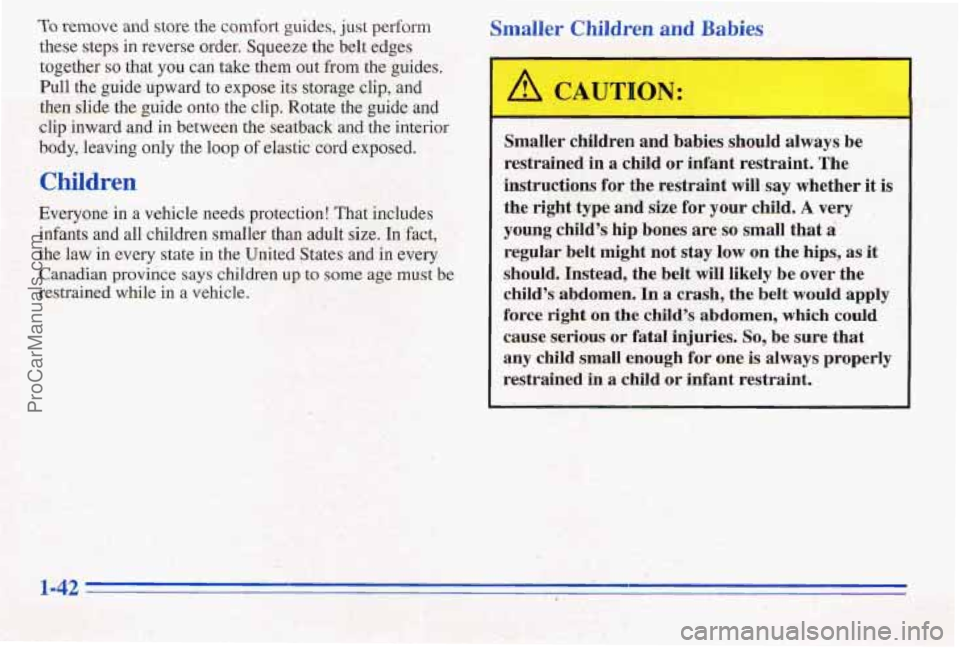
To remove and store the comfort guides, just perform
these steps in reverse order. Squeeze the belt edges
together m that you can take them out from the guides.
Pull the guide upward to expose its storage clip, and
then
slide the guide onto the clip. Rotate the guide and
clip,inward and in between
the seatback and the interior
body, leaving only
the loop of elastic cord exposed. 7hA'E
&$udren ig>- I ?
Everyone in a vehicle needs protection! That includes
infants and all children smaller than adult size.
In fact,
the law in every state in the United States and in every
Canadian province says children up to someage must be
restrained while
in a vehicle.
Smaller Children and Babies ,
Smaller children and babies should always be
restrained in a
child or infant restraint. The
instructions far the restraint will say whether it is
the right type and size for your child. A very
young child's hip bones
are so small that i
regular belt might not stay low on the hips, as it
should. Instead, the belt will likely be over the
child's abdomen.
In a crash, the belt mdd apply
force right
on the child's abdomen, which could
cause serious or fatal *juries.
So, be sure that
any
child small enough for one is always properly
restrained
m a child or infant restraint.^
ProCarManuals.com
Page 50 of 370
Never hold a baby in your arms while riding in a’
vehicle. A baby doesn’t weigh much -- until a
crash. During
a crash a baby will become so
heavy you can’t hold it. For example, in a crash
CAUTION: (Continued)
CAUTION: (Continued)
at only 25 mph (40 km/h), a 12-lb. (5.5 kg) baby
will suddenly become a 240-lb.
(110 kg) force on
your arms. The baby would be almost impossible
to hold.
Secure the baby
in an infant restraint.
I
1-43
ProCarManuals.com
Trending: change wheel, hood open, climate control, air suspension, audio, lock, seats
